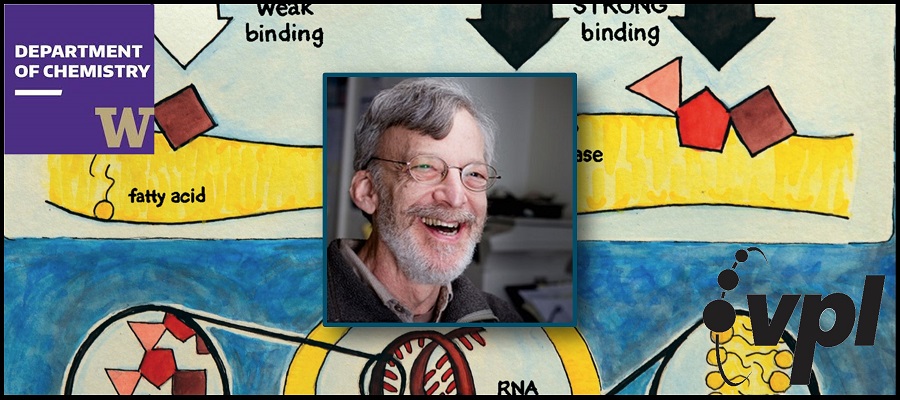VPL Team members Roy Black, Sarah Keller and other collaborators in the Keller Lab in the Chemistry Department at the…
We propose that the building blocks of RNA (nucleobases and ribose) bound to self-assembled prebiotic membranes. We have previously demonstrated that the bases bind to membranes composed of a prebiotic fatty acid, but evidence for the binding of sugars has remained a technical challenge. Here, we used pulsed-field gradient NMR spectroscopy to demonstrate that ribose and other sugars bind to membranes of decanoic acid. Moreover, the binding of some bases is strongly enhanced when they are linked to ribose to form a nucleoside or – with the addition of phosphate – a nucleotide. This enhanced binding could have played a role in the molecular evolution leading to the production of RNA.
The membranes of the first protocells on the early Earth were likely self-assembled from fatty acids. A major challenge in understanding how protocells could have arisen and withstood changes in their environment is that fatty acid membranes are unstable in solutions containing high concentrations of salt (such as would have been prevalent in early oceans) or divalent cations (which would have been required for RNA catalysis). To test whether the inclusion of amino acids addresses this problem, we coupled direct techniques of cryoelectron microscopy and fluorescence microscopy with techniques of NMR spectroscopy, centrifuge filtration assays, and turbidity measurements. We find that a set of unmodified, prebiotic amino acids binds to prebiotic fatty acid membranes and that a subset stabilizes membranes in the presence of salt and Mg2+. Furthermore, we find that final concentrations of the amino acids need not be high to cause these effects; membrane stabilization persists after dilution as would have occurred during the rehydration of dried or partially dried pools. In addition to providing a means to stabilize protocell membranes, our results address the challenge of explaining how proteins could have become colocalized with membranes. Amino acids are the building blocks of proteins, and our results are consistent with a positive feedback loop in which amino acids bound to self-assembled fatty acid membranes, resulting in membrane stabilization and leading to more binding in turn. High local concentrations of molecular building blocks at the surface of fatty acid membranes may have aided the eventual formation of proteins.
Primordial cells presumably combined RNAs, which functioned as catalysts and carriers of genetic information, with an encapsulating membrane of aggregated amphiphilic molecules. Major questions regarding this hypothesis include how the four bases and the sugar in RNA were selected from a mixture of prebiotic compounds and colocalized with such membranes, and how the membranes were stabilized against flocculation in salt water. To address these questions, we explored the possibility that aggregates of decanoic acid, a prebiotic amphiphile, interact with the bases and sugar found in RNA. We found that these bases, as well as some but not all related bases, bind to decanoic acid aggregates. Moreover, both the bases and ribose inhibit flocculation of decanoic acid by salt. The extent of inhibition by the bases correlates with the extent of their binding, and ribose inhibits to a greater extent than three similar sugars. Finally, the stabilizing effects of a base and ribose are additive. Thus, aggregates of a prebiotic amphiphile bind certain heterocyclic bases and sugars, including those found in RNA, and this binding stabilizes the aggregates against salt. These mutually reinforcing mechanisms might have driven the emergence of protocells.
